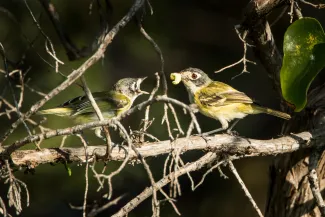
The U.S. Fish and Wildlife Service recently announced the recovery of the black-capped vireo, a small migratory songbird that breeds and nests in Oklahoma, Texas and northern Mexico.
Only 350 birds remained across the vireo’s range when the bird was listed as an endangered species in 1987; less than 50 were thought to live in Oklahoma.
“After 31 years, Oklahoma’s population has grown to more than 4,000 birds,” said Matt Fullerton, endangered species biologist with the Oklahoma Department of Wildlife Conservation. “The bulk of these birds can be found at the Wichita Mountains Wildlife Refuge near Lawton and the nearby Fort Sill Military Installation.”
Nesting pairs also have been found just outside of the refuge and military base and at Quartz Mountain Nature Park near Lone Wolf. Another small population was recently rediscovered on private property in Blaine County.
“Black-capped vireos need thousands of acres of low-growing oaks and scrubby habitat,” Fullerton said. “Our partners in conservation have done a great job of managing for just this type of habitat and have been a leading influence in the bird’s recovery.”
J.D. Strong, director of the Wildlife Department, also praised the coordination of habitat management efforts. “The black-capped vireo is a success story that shows the power of conservation partnerships,” Strong said. “Now our challenge is to redouble efforts to make sure those partnerships continue – along with valuable habitat restoration work and research – so that vireos and Oklahoma’s other fish and wildlife populations remain healthy.”
While in our state, these songbirds feed on insects, especially butterfly and moth caterpillars. Suspended nests are built 2-6 foot above the ground and egg-laying reaches its peak in June. After a four-month nesting season in Oklahoma, these birds migrate and overwinter in Mexico’s western coastal states.
The vireo will be officially removed from the List of Endangered and Threatened Wildlife and Plants in mid-May. Surveys for the bird will continue at least 12 years to ensure the risk of extinction has passed.
“This announcement comes at the perfect time,” Fullerton said. “Black-capped vireos are arriving in Oklahoma now for their breeding season and will be here until August and September.”
“Spending time at the Wichita Mountains – bird watching or exploring the trails – would be a great way to celebrate this conservation milestone.”